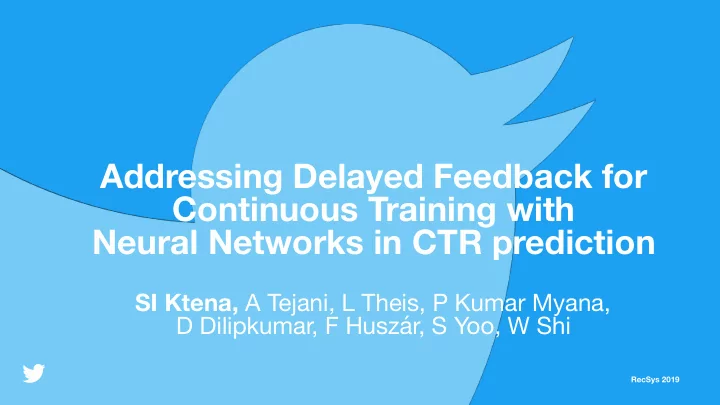

Addressing Delayed Feedback for Continuous Training with Neural Networks in CTR prediction SI Ktena, A Tejani, L Theis, P Kumar Myana, D Dilipkumar, F Huszár, S Yoo, W Shi RecSys 2019
Background Why continuous training? � 2
Background Why continuous training? � 2
Background New campaign IDs + non-stationary features � 3
Challenge: Delayed feedback Fact: Users may click ads after 1 second 1 minute or 1 hour
Challenge: Delayed feedback Why is it a challenge? Should we wait ? → Delays model training Model quality Training Delay Should we not wait ? How do we decide the label?
Solution: accept “fake negative” Event Label Weight (user1, ad1, t1) imp 1 Time (user2, ad1, t2) imp 1 (user1, ad1, t3) click 1
Solution: accept “fake negative” Event Label Weight (user1, ad1, t1) imp 1 Time (user2, ad1, t2) imp 1 (user1, ad1, t3) click 1
Solution: accept “fake negative” Event Label Weight (user1, ad1, t1) imp 1 Time (user2, ad1, t2) imp 1 (user1, ad1, t3) click 1
Solution: accept “fake negative” Event Label Weight (user1, ad1, t1) imp 1 same Time (user2, ad1, t2) imp 1 features (user1, ad1, t3) click 1
Solution: accept “fake negative” Event Label Weight (user1, ad1, t1) imp 1 same Time (user2, ad1, t2) imp 1 features (user1, ad1, t3) click 1
Solution: accept “fake negative” Event Label Weight (user1, ad1, t1) imp 1 same Time (user2, ad1, t2) imp 1 features (user1, ad1, t3) click 1 Assume X #Clicks out of Y #Impressions Works well when CTR is low , where X/Y ~= X/ (X+Y)
Background Delayed feedback models � 7
Background Delayed feedback models � 7
Background Delayed feedback models ● The probability of click is not constant through time [ Chapelle 2014 ] � 7
Background Delayed feedback models ● The probability of click is not constant through time [ Chapelle 2014 ] ● Second model similar to survival time analysis models captures the delay between impression and click � 7
Background Delayed feedback models ● The probability of click is not constant through time [ Chapelle 2014 ] ● Second model similar to survival time analysis models captures the delay between impression and click ● Assume an exponential distribution or other non- parametric distribution � 7
Background Delayed feedback models ● The probability of click is not constant through time [ Chapelle 2014 ] ● Second model similar to survival time analysis models captures the delay between impression and click ● Assume an exponential distribution or other non- parametric distribution � 7
Background Delayed feedback models � 8
Our approach
Our approach Importance sampling ● p is the actual data distribution ● b is the biased data distribution Importance weights � 10
Our approach ● Continuous training scheme -> potentially wait infinite time for positive engagement ● Two models ○ Logistic regression ○ Wide-and-deep model ● Four loss functions ○ Delayed feedback loss [ Chapelle, 2014 ] ○ Positive-unlabeled loss [ du Plessis et al., 2015 ] ○ Fake negative weighted ○ Fake negative calibration � 11
Our approach ● Continuous training scheme -> potentially wait infinite time for positive engagement ● Two models ○ Logistic regression ○ Wide-and-deep model ● Four loss functions ○ Delayed feedback loss [ Chapelle, 2014 ] ○ Positive-unlabeled loss [ du Plessis et al., 2015 ] ○ Fake negative weighted both rely on ○ Fake negative calibration importance sampling � 11
Loss functions Delayed feedback loss Assume exponential distribution for time delay � 12
Loss functions Delayed feedback loss Assume exponential distribution for time delay � 12
Loss functions Fake negative weighted & calibration Don’t apply any weights on the training samples, only calibrate the output of the network using the following formulation � 13
Loss functions Fake negative weighted & calibration Don’t apply any weights on the training samples, only calibrate the output of the network using the following formulation � 13
Experiments
Offline experiments Criteo data ○ Small dataset & public ○ Training - 15.5M / Testing: 3.5M examples RCE: normalised version of cross-entropy (higher values are better) � 15
Offline experiments Criteo data ○ Small dataset & public ○ Training - 15.5M / Testing: 3.5M examples RCE: normalised version of cross-entropy (higher values are better) � 15
Offline experiments Twitter data ○ Large & proprietary due to user information ○ Training: 668M ads w. FN / Testing: 7M ads RCE: normalised version of cross-entropy (higher values are better) � 16
Offline experiments Twitter data ○ Large & proprietary due to user information ○ Training: 668M ads w. FN / Testing: 7M ads RCE: normalised version of cross-entropy (higher values are better) � 16
Online experiment Online (A/B test) Pooled RCE: RCE on combined traffic generated by models RPMq: Revenue per thousand requests � 17
Conclusions ● Solve problem of delayed feedback in continuous training by relying on importance weights ● FN weighted and FN calibration proposed and applied for the first time ● Offline evaluation on large proprietary dataset and online A/B test � 18
Future directions ● Address catastrophic forgetting and overfitting ● Exploration / exploitation strategies � 19
Questions? https://careers.twitter.com @s0f1ra
Recommend
More recommend